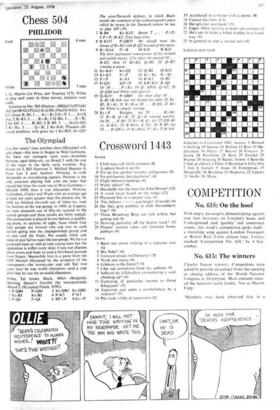Chess 504
PHILIDOR
J. G. Martin (1st Prize, KW Tourney 117). White to play and mate in three moves; solution next week.
Solution to No. 503 (Ducker—BB2q3/1n2N1p1/ 5b2/1pr IRN2/1P2nk2/K1p3R I JP4p1Q/4rb2): Kt-
K3, threat R-B5. Kt x R; 2 Q x P. I . • • Kt(5) else; 2 R-R3. 1 . . . B x R; 2 Q-R.4. 1 . . R x R;
2 Kt-Q5. 1 . R-B2; 2 R-B5. 1 . . Kt(2)-Q3; 2 R x Kt. I . . . QxB; 2 Kt-Kt6. Pleasant all- round problem, with good try I Kt-R6?, Kt-Q3 I
The Olympiad
In a few weeks' time another chess Olympiad will take place—this time in Siegen in West Germany. We have our youngest team ever—Jonathan Penrose, aged thirty-six, on Board 1 with the rest of the team in the fairly early twenties: Ray Keene on 2, Bill Hartston 3, Michael Basman 4, Peter Lee 5 and Andrew Whiteley 6—with Alexander as non-playing captain. Penrose is the only common playing link with the team that played last time the event was in West Germany— Munich 1958; then it was Alexander, Penrose, Golombek, Clarke and Wade with an average age at least ten years greater than the present one. In 1958 we finished eleventh out of thirty-six, near the bottom of the top group; in 1968, at Lugano, we were sixteenth out of fifty-six (second in the second group) and these results are fairly typical. The tournament is played in two halves; a qualify- ing event, in sections of eight, from which four final groups are formed (the top two in each section going into the championship group and so on)—and the finals. We usually either just make or just fail to make the top group. We have a good and keen as well as very young team but the opposition is stiffer every time; 1 rate our chances about evens and hope to send a first-hand account from Siegen. Meanwhile here is a game from the 1958 Munich Olympiad by the sensation of the tournament—the twenty-one year old Tal; two sears later he was world champion—and a year after that he was the ex-world champion.
White, Tal (ussx). Black, Milev (Bulgaria). Opening, Queen's Gambit (by transposition). (Board 5, Olympiad Finals, 1958.) I P-Q84 P-QB4 2 Kt-QB3 Kt-QB3 3 Kt-B3 Kt-B3 4 P-K3 P-K3 5 P-Q4 P-Q4 6 BPxP KKtxP The semi-Tarrasch defence, in which Black avoids the weakness of an isolated queen's pawn which lie incurs in the Tarrasch (where he has to play KPxP).
7 B-B4 Kt-Kt3? Better 7 , . . PxP; 8 PxP; B-K2. Text loses time.
8 B-Kt5! P-QR3? He should meet the threat of Kt-KS with B-Q2 instead of this move.
9 B x Ktch P x B 10 0-0 B-Kt2 The first unpleasant consequence of his seventh and eighth moves; if he plays the natural 10 . B-K2, then 11 Kt-KS, Q-B2; 12 Q-B3! winning a pawn.
1I Kt-K41 Kt-Q2 12 Q-B2 Q-Kt3 13 Kt-K5 P xP 14 Kt x Kt K x Kt 15 PxP K-K1 16 B-K3 Q-132 17 P-Q5! KPxP 18 KR-K11 K-Q1 Or 18 . . . PxKt; 19 QxKPch, Q-K2; 20 Q-QB4 and White wins quickly.
19 Q-Kt31 P-QB4? He must play 19 . . K-Bl (B-Kt6 was the threw) but after 20 Kt- BS, B x Kt; 21 B x B or 20 . . . B-Q3; 21 Kt- R4 White is clearly winning.
20 Kt xP Resigns. (a) 20 . . . Bx Kt; 21 B x B, Q x B; 22 QxB winning quickly. (b) 20 ... K-131; 2! Kt x B, Q x Kt; 22 QR-Bl eh, K-Ktl; 23 B-B4ch, K-R2; 24 R-87. (c) 20... R-QKt1; 21 Kt-K6ch, Px Kt; 22 B-Kt6.






























 Previous page
Previous page